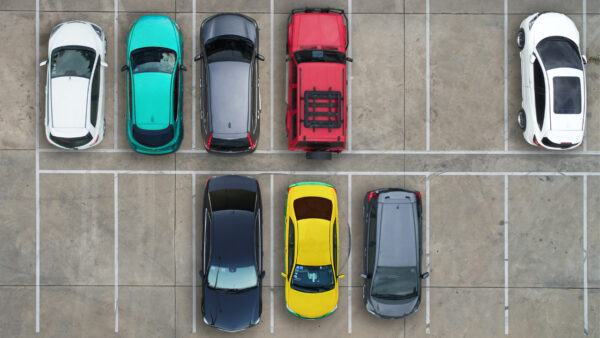Where Is It Illegal to Park a Car?
Some people might be wondering where it’s illegal to park a vehicle in BC. After all, you can’t just park a car anywhere. Although, wouldn’t that be nice?
Let’s go through the rules for beautiful British Columbia (BC Motor Vehicle Act) and then we’ll go through some various cities because, of course, each city may be slightly different than the next with their rules and regulations for parking and stopping vehicles. For a related article, check out Right-of-Way in the Parking Lot.
Where is it Illegal to Park a Car in Beautiful British Columbia?
These are the general province-wide (Motor Vehicle Act British Columbia) laws.
- Where the curb is painted yellow
- On the ‘wrong’ side of the road i.e. against traffic direction
- Where your vehicle obstructs the view of a stop sign or other traffic sign
- On a bridge
- In a highway tunnel
- In a bike lane
- Within 15 meters of the nearest rail of a railway crossing;
- Within 6 meters on the approach to a stop sign, a flashing beacon, or traffic control signal located at the side of a roadway;
- Within 6 meters of either side of the entrance to or exit from a hotel, theatre, public meeting place, dance hall, fire hall, or playground in a rural area;
- Within 6 meters of a traffic light
- Within 6 meters of a crosswalk
- Within 6 meters of an intersection
- Within 5 meters of a fire hydrant – if you want to get technical, this is measured from a point at the curb or edge of the roadway that is closest to the fire hydrant
- Across the entrance to a public or private driveway
- Across the entrance to a back lane
- Across the entrance to an intersection
- On a sidewalk
- On a crosswalk
- On a boulevard
- In an intersection
- Where a traffic sign prohibits parking
- *When parking parallel, make sure your vehicle is within 30 cm (1 foot) of the curb.
Use common sense and be sure to park where it is safe and legal, and where you are not blocking traffic.
Check out the motor vehicle act here to read the laws yourself.
** These rules may vary according to municipal by-laws.
How Far Can You Park From an Intersection in Vancouver?
How far you can park from an intersection will vary slightly according to municipal/city bylaws. Let’s take a look at the beautiful city of Vancouver, British Columbia, and find out what their laws say about parking close to intersections.
Do not park:
- Section 17.5 (c): Within 6 m of the nearest edge of the closest sidewalk on an intersecting street
- Section 17.5 (d): When there is no sidewalk, 9 m of the nearest edge of the pavement of an intersecting street
- Section 17.5 (a): Within 1.5 m of an intersecting lane
- Section 17.2 (d): Within 1.5 m of a private road, boulevard crossing, or sidewalk crossing
- Section 17.4 (b): Within 6 m of either side of a crosswalk.
- Section 17.2 (a): Within 6 m of the approach side of a stop sign.
- Section 17.2 (c): Within 5 m of a fire hydrant, measured from either side of the hydrant, starting from the nearest curb or road edge
Do not park:
- Sections 17.4 (c), (d): On sidewalks or sidewalk crossings
- Section 18.1 (c): More than 30 cm from the curb, or edge of the roadway
- Section 18.1 (b): In the opposite direction of traffic
- Section 18.1 (a): Unparallel with the curb or roadway unless there are marks or signs that indicate angle parking
Question: Can I Park My Car Blocking My Own Driveway?

Some people wonder if you’re allowed to park blocking your own driveway. It’s yours, so what’s the problem, right?
It is illegal to park blocking any driveway in BC (and, a lot of other places in Canada and the U.S.), even if it’s your own driveway.
Please note that there is a difference between “No Parking” and “No Stopping” Basically, you can stop the car blocking the driveway if you’re only going to be a few moments. For example, dropping someone off.
But leaving the car there by itself for any amount of time could result in a ticket. Why is this? Well, no one seems to know. But we can only make a guess about emergency situations and ease-of-access to emergency crews.
Related articles:
- What to Bring to the Road Test & Fees
- Car Rental & Car Sharing Options
- Get Your ICBC Drivers Abstract FREE (Driving Records)
Carmen Cohoe
Carmen became a driving instructor in beautiful North Vancouver at the age of 22 due to some crazy people who agreed to hire her. After that, there was never a dull moment teaching many different folks from many different places how to drive using automatic and standard vehicles and a minivan.



I’m curious about the 6m from an intersection prohibition. This restriction does not appear in s. 189 of the MVA – though it is set out in the “drive smart” handbook from ICBC. S. 189 makes it illegal to park within:
(h) 6 m of a crosswalk;
(i) 6 m of a “flashing beacon, stop sign or traffic control signal”
(j) 6 m either side of the entrance to or exit from a hotel, theatre, public meeting place, dance hall, fire hall or playground in rural area;
It is silent on the distance back from an uncontrolled or unmarked intersection, unless that rule is buried somewhere else (maybe in some regulation?).
Cheers.
I think the city of Vancouver has some by-law where you can only park for 3 or 4 hours regardless of the signs (will have to look that up)… I don’t think it matters what kind of plate you have. Different cities/municipalities have different by-laws, some that include things like allowing people to park closer to the entrances to lanes or even intersections/stop signs. Unfortunately it seems it’s a bit annoying to look up the by-laws..
Indeed, many municipalities will enact by-laws that require more than compliance with the provincial legislation found in the Motor Vehicle Act. Generally speaking, they’ll make sense – such as not being allowed to park within 3 metres of the entrance to a back lane (thus blocking the view for drivers both exiting and entering, as well as pedestrians who are still technically on the sidewalk and must be given right of way).
Because of the importance of maintaining sight lines, and enabling pedestrians (particularly the young/short/etc types – i.e. students) to see and be seen, some municipalities deliberately prohibit parking on the ‘school side’ of the road in front of schools during the hours when students are likely to be present. I think you’ll find this in all three of the north shore municipalities, in fact. Makes sense.
It also makes sense that the mighty Motor Vehicle Act allows municipalities to ‘modify’ provincial legislation in some cases. For instance, in the case of a T-Intersection, to allow parking along the stem of the T on the opposite side of the road from the intersecting street, never mind that 6 metre rule. Another example is that municipalities may extend (but not reduce) the hours that school speed zones are in effect, reflecting the fact that school playgrounds and facilities may often be used by kids beyond 8/5 M/F on days when school is regularly held.
None of this parking stuff has anything whatsoever to do with having Yukon plates on your car (but don’t leave your car parked on Lonsdale Avenue in North Vancouver overnight, because they do have a bylaw prohibiting that) and don’t expect to see taxis in North Vancouver making use of the furthest end of a bus zone for pickup and dropoff in North Van, because although it is allowed, nobody seems to be aware of it.
Also, you’re not even allowed to stop in front of, or within 5 metres of, a fire hydrant, never mind park! Unless, of course, the fire hydrant is adjacent to a stop sign …
Just because it’s not a BC plate?